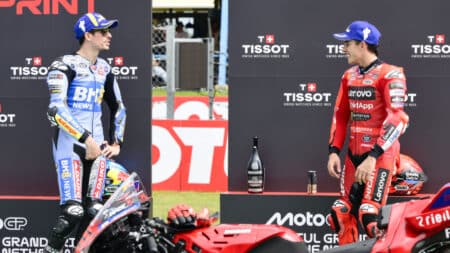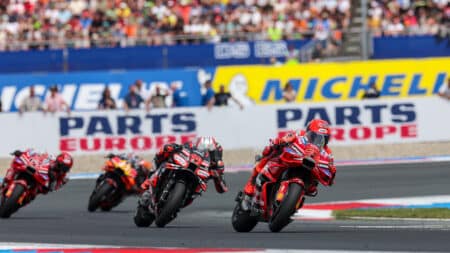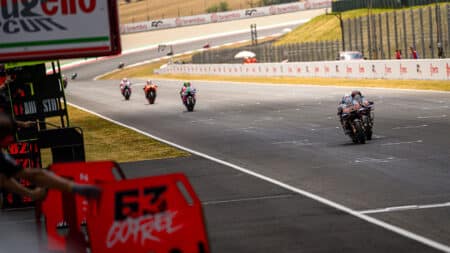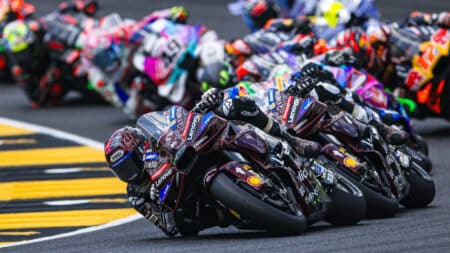Well, it appears that whoever coined the term ‘you can’t teach an old dog new tricks’ didn’t know what they were talking about.

On Sunday in Italy a middle-aged man defeated a young phenomenon for several reasons. Firstly, he’s learned a new trick or two.
I can only assume that Valentino Rossi discovered his new way of riding his Yamaha YZR-M1 by reading old copies of Grand Prix annual Motocourse because he seems to have adopted the outlandish riding style of 1990s BSB champ James Whitham. The Yorkshireman rode in a highly unusual fashion, with upper body completely out of line with the motorcycle, neck craning towards the inside of the corner, as if he was literally dragging his machine to the apex.

Whitham developed that style while riding Suzuki’s recalcitrant 1992 GSX-R750 and it worked well for him in subsequent seasons. And now it seems to work just as well for Rossi who’s been thinking scientifically about what he can do to close the gap on young pup Marc Márquez, riding Honda’s quicker-steering RC213V.
“If you want to stay on top you must look at what the fastest riders are doing,” Rossi affirms. “I now use more of the top of my body to move outside of the bike to improve turning. I watch and I try to modify my position on the bike and the movement of the bike. I now move forward more to avoid wheelies.”
Moving his weight forward proves Rossi’s old assertion that the man is more important than the machine. While some riders might allow the anti-wheelie electronics to kick in to reduce time-wasting wheelies, Rossi knows it is better to avoid the ignition cuts, which only hurt acceleration, so he uses his own weight to overcome the rider aids that are put there to help him.
Of course, it’s not all Rossi. His 2014 M1 is geared much more to his style than last year’s bike, though the biggest improvement for this year is a new gearbox that allows clutch-less downshifts, thus negating much of Honda’s advantage during braking.

“The gearbox makes the bike more stable so I can brake a lot deeper,” Rossi adds. “I can really use the engine-braking to stop so I can divide grip more between the front and rear. Last year it was all on the front.”
2014 so far
Wins
Marc Márquez: 11
Dani Pedrosa: 1
Valentino Rossi: 1
Poles
Marc Márquez: 10
Dani Pedrosa: 1
Jorge Lorenzo: 1
Aleix Espagaró: 1
Fastest laps
Marc Márquez: 10
Dani Pedrosa: 2
Álvaro Bautista: 1
And then there was what happened at Misano. When did you last see a Yamaha out-accelerate a Honda during a MotoGP race? I can’t remember but it must be a long time ago. And this didn’t happen just once, it happened on two occasions – Rossi twice powering past Márquez in a straight line.
That probably goes back to Friday’s heavy rainfall which wiped out the first day of practice. The Yamaha is a more neutral motorcycle than the Honda, which can take more tweaking to get right. Usually Honda riders follow a straightforward schedule as they work towards the perfect set-up: on Friday they work on old-school settings like suspension and geometry, then once that’s all good they spend Saturday adjusting the electronics to suit. At Misano they had to cram that work into two days and they obviously didn’t get everything done, most likely because the circuit is slippery and the RCV can take a lot of taming when traction is lacking, due to its lighter crank and more aggressive power delivery. Márquez’s lack of acceleration during the race was probably due to wheelspin triggering the traction control and reducing power with ignition cuts.

Obviously, MotoGP isn’t only a race on the track. A lot of racing is also done in the pits. Friday’s rain affected both Márquez and Rossi. Quite simply, the Italian, his crew and Yamaha did a better job than the Spaniard, his crew and Honda.
In the race itself Márquez was obviously pushing beyond his own far-out limits in a desperate attempt to stay with Rossi. On several occasions he ran wide through the fast rights towards the end of the lap and he kept missing apexes. Respect to him for deciding to keep fighting for the win, rather than feathering the throttle and settling for a safe second place. Even in his comfy championship position, most riders would have decided discretion is the better part of valour. Márquez is a proper racer: he will keep playing with the limit unless circumstances make that utter folly.
And then he fell off. In fact he didn’t really fall off because just as Rossi has discovered a new way of riding, Márquez has discovered a new way of crashing. He uses so much lean angle, with his knee and elbow down, that when he has a low-side he’s already on the ground. It’s an excellent way to have an accident.

When Márquez lost the front in that slow right-hander on Sunday, bike and rider continued as one for a couple of seconds, skating across the tarmac. During those seconds – which probably felt like half an hour to Márquez – he was pushing with all his might through his elbow and knee in the hope of getting the bike back onto its tyres. Only when the RCV came towards a halt did the bike slew around and eject its pilot. It was a crash but only just.
Márquez had done exactly the same a few weeks earlier during Brno testing: bike on its side, knee, backside and elbow on the ground. That time he didn’t lose control. This time he did.
I salute Rossi for the win that many of us thought would never come and I salute Márquez for showing us a new, painless way to crash! The only problem, of course, is that we need to be able to achieve 64 degrees of lean before we too can crash like that…










